Audi A4 matures into sports-luxury sedan
Filed under: Weekly test drives, Autos
By John Gilbert
The first Audi A4 was built back in 1994 and introduced to the U.S. as a 1995 model. That was 23 years ago, and the car remains near and dear to my heart because that also was the year I was invited to join the North American Car of the Year jury.
Rookie or not, I was fully confident in voting for the all-new Audi A4 because it met and exceeded all the criteria for being new, uniquely styled, for having high technology, and for being a superb car to drive.
Audi had built great cars in Ingolstadt, Germany, for many years before that, but the A4 was a breakthrough as a moderately priced and moderately sized sedan, combining the luxury of the larger Audi autobahn cruisers and the fuel-efficiency so important to buyers world wide. Audi started out racing cars as Auto Union, which brought several companies together to compete with Mercedes and, later, BMW.
For a number of years, and through four generations of improved technology, the A4 was one of the best bargains in the automotive world, available starting on the bargain side of $30,000. It was always a well-balanced, safe car, and it had the quattro system of all-wheel drive that Audi had devised and was already acclaimed worldwide. The front-wheel-drive A4 was a good deal, but the quattro model was only a $1,500 hit on the sticker. Wise consumers learned early that for $1,500, you not only gained all-wheel drive, but when you traded it in five years later, it was worth about $3,000 more with quattro.
The quattro concept was based on performance. When going around a tight curve the outside two wheels have to turn farther than the inside, so Audi’s quattro — lower-case letters, please — provided more torque to the outside wheels in curves. While helping speed and roadholding in racing curves, the quattro system provided improved safety and control on highways and streets in all weather conditions, as an exponent.
A lot of years have passed since 1995, and the number of fantastic cars has proliferated beyond the scope of what any of us foresaw back then. But it all came back to me recently when I had a chance to spend a week with a 2018 Audi A4 quattro, with a manual 6-speed transmission.
The car, now in its fifth generation, was dark red, called Matador Red metallic, and its understated luxury radiated whenever or wherever you parked it or drove it. Driving the car is a real treat, continuing a trait common to all Audis. The A4 has grown, or maybe matured is the best word, because it’s no longer the company’s efficiently stubby entry-level sedan, a role now filled by the very neat A3, allowing the A4 to age gracefully, retaining its sporty demeanor as it has grown into an “entry-luxury” car — a downsized version of the higher end A5, A6, A7 and A8 models.
Climbing aboard, you are taken with the feel of security and luxury, from the leather seats and soft-touch dashboard and finely fitted seams everywhere. The supportive bucket seats amplify that feeling, all before you’ve even started playing with the instrumentation, which I find the most impressive of any manufacturer in the world. More on that later.
The sticker delivered a bit of shock to my system. The A4 quattro listed for $40,500, which wasn’t bad, but as tested the car stood at $51,650. The high-tech stuff that all compiled on board as options can justify even that price, but it is a stretch upward from entry-level.
Under the hood, the tried and true 2.0-liter 4-cylinder engine is turbocharged to deliver 252 horsepower and 273 foot-pounds of torque. The 6-speed stick is a treat, especially with the quattro system’s ability to cling to the roadway when you drive aggressively around curves.
It also comes with start-stop to save you some gas at stoplights, leather seats, a power panoramic sunroof, and all the safety stuff, such as multiple airbags, Audi’s antilock brakes with accompanying electronic brake-force assist and the ability to prevent low-speed collisions in city driving. Full stabilization control also joins the standard equipment list.
The Premium Plus package adds 18-inch styled wheels, a Bang & Olufsen sound system with 3D sound, a built-in alarm with motion detector, LED headlights (to go with the standard LED taillights), and the Navigation and Telematics package with Audi’s unique navigation system for the virtual cockpit, boost the price by over $6,000. And the Sport Plus package is worth another $3,400, with dynamic steering, sport seats and adaptive sport suspension, plus the S-Line interior trim to set your car apart from other A4s.
While the driving is what leaves the best impression, there are some surprises there, too. The coordination between the impressive turbo power, the transmission, and the direct fuel-injection feeds the computer and allows tremendous flexibility in performance. You can take off as hard as you want, and even with a stick, you can enjoy shifting a lot or relax and shift only a little.
If you approach an intersection in, say, fourth gear, as you decelerate and see there’s nothing coming, you can downshift and get more revs immediately, or simply step on the gas and let the computer pull out a bit more torque for a smooth and easy rise from crawl speed.
Also, more than once I got onto the freeway, shifting up to fourth gear, and then, hearing no complaints from the engine, forgetting to go up to fifth or sixth because it cruised so easily at 70 that I forgot I was only in fourth. Even with a few of those brain-fades, we got over 30 miles per gallon, and a couple times reached the EPA highway estimate of 33.
If you chose the front-wheel-drive A4, you might get more gas mileage, with EPA highway estimates of 37, but I would bet in many cases the mileage would be almost identical. And if you’ve ever driven up the hills of Duluth, Minnesota, and realize what winter storms can be like, you might trade a couple mpg for the all-wheel drive quattro.
My favorite feature might be the aforementioned nav screens. The normal center-stack screen does a good job, and can have its information screens altered easily by a console knob. Playing around with it, I found that you can have a flat map of streets and so forth, or you can switch it and come up with a Google Maps screen, which is from actual satellite photos, with building, street and tree detail. Impressive. And very neat.
Meanwhile, the steering wheel is loaded with technology itself, and one of the features is that you can alter the look of the instrument panel, which starts with the normal large tachometer on the left and large speedometer on the right, with a panel between them for various items you select. One of those items is to duplicate the nav screen.
Sure enough, you get the nav map between the tach and speedometer. But if you click it again, it goes to the Google Map real-life satellite view. And if you click it still more, the large tach and speedometer shrink to about one-fourth their size, out on the extremities of the whole instrument panel, and the Google Map screen spans from left to right, a panoramic view of the area ahead of your car, only much clearer.
It is so amazing, I parked in my driveway and played with it for several minutes after getting to my rural home. I enlarged the panoramic view of my location until it showed my position in my driveway’s turn-around area, as well as my house and garage and tree-lined driveway. I magnified it more until it felt like I was parachuting down into my property.
Come to think of it, you can have your autonomous self-driving vehicle. I’ll take the A4; I believe you could tape over the windshield and drive from here to Chicago by using only the nav screen on the instrument panel for your forward vision.
By the way, I still believe I was right voting for the Audi A4 as Car of the Year back in 1994. Nobody can remember what actually won, but the A4 was the best and most enduring car of that year, and it is still among the best cars in the world.
Mazda6 adds turbo power in 2018 model
Filed under: Weekly test drives, Autos
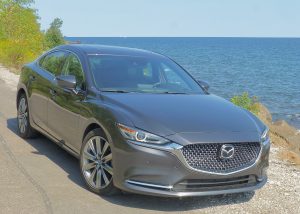
After an upgraded 2017.5 model, the 2018 Mazda6 becomes a hot performer with a turbo version of its 2.5 engine.
By John Gilbert
It’s easy to poke fun at Mazda’s trademark “Zoom-zoom” catch-phrase, but for the 2018 Mazda6, the company could simplify it to “ZOOM!”
The sportiness inherent in all Mazda products is real, and while the bold-face type and italics are mine, the new Mazda6 has earned them by spiking the previous Mazda6’s personality with a turbocharger to turn the top model with the enhanced 2.5-liter 4-cylinder engine into a sizzling performer.
Mazda resisted turbocharging since redesigning its 2.0 and 2.4 with the company’s revolutionary Skyactiv engine concept, which calls for holistic, clean-sheet design incorporating all the latest techniques in harmony to extract every bit of power and fuel-efficiency. The finished product came with a 13-to-1 compression ratio but still burned best with 87 octane regular fuel.
When the company’s largest SUV, the CX-9 was redesigned, Mazda, which had dropped its V6 engine, still had to compete with the V6es in comparative Honda, Toyota, Nissan and U.S. vehicles. Easiest way to do that was to turbocharge the 2.5 in the CX-9, and it worked more than just satisfactorily.
Mazda technology is unfolding almost too fast, and a totally redesigned Mazda6 is scheduled for sometime in 2019, but meanwhile, the already sleek Mazda6 got a feature and interior upgrade for mid-2017, called the 2017.5 model. The 2018 Mazda6 doesn’t look different at a glance, but to take on competition such as the all-new Honda Accord the latest Nissan Altima and Toyota Camry, Mazda figured to shift the turbo 2.5 from the big SUV into the Mazda6 midsize sedan.
The very classy 2018 Mazda6 Signature model I got for a Labor Day week’s test drive was equipped with the 2.5-liter turbocharged 4, and the turbo’s 225 horsepower and 310 foot-pounds of torque — which would have been impressive for a V6 just a couple of years ago — were startling upgrades from the 184 horses and 185 foot-pounds of the normally aspirated 2.5.
A footnote to the preferences of U.S. buyers to go after SUVs, pickup trucks, or compact cars, my suspicion is that the sedan category might be streamlining itself in the future, because the newest midsize cars are as big and roomy as large cars have been. And the midsizers outperform their heftier relatives with ease.
I love to drive hot cars that might be overpowered but fun, but I also can appreciate the fine engineering of certain high-tech advancements in whatever size. I always was aware the previous 2.5 lacked the sudden jolt of larger engines on initial takeoff, but it also revved easily and readily to real-world levels. So I found the normally aspirated 2.5 more than adequate in the 2017.5 model I reviewed early in the 2018 calendar year.
In fact, that one was a stunning red color, so when the new grey Mazda6 appeared — called, boringly, “Machine Gray Metallic” — I was a bit let down, thinking it was just more of the same car.
The car looked classy, so classy that I thought it had traded sportiness for class in the exchange. Then I opened the door and saw the deep-chestnut Nappa leather seats and the revised interior. More class, without depicting sportiness. After that, I climbed behind the steering wheel into the well-supported driver’s seat and hit the start button. Shifting into “D,” I hit the gas, and, without question, instead of “Zoom-zoom” I had “ZOOM!” at the touch of my right toe.
The largest and roomiest of Mazda’s sedans is clearly designed and built to take on the best from Honda, Toyota and Nissan, and even their upscale arms of Acura, Lexus and Infiniti, for zip, and still provide over 30 miles per gallon when you keep your foot off the gas.
By Skyactiv tradtion, Mazda engineers go well beyond mere engine power. The new Mazda6 handles with quick-steering and firmed up suspension front and rear, bolstered by stabilizer bars at both ends, and you the little toggle switch on the console is a big benefit if you want to delve deeper into sporty handling. Switching it without even looking, you can alter suspension firmness, the Mazda-built automatic’s shift points, and the quick and precise steering to comfort or sporty choices. I never found the sporty settings to be harsh, and at its sportiest, they do noticeably add performance and handling quickness to the car.
Quite amazingly, the tightening of the settings combined with the instant power of the turbocharged engine makes the 2018 Mazda6 perform much more like a sports sedan than a luxury car, despite its classy good looks.
Sticker price was $34,750 on the loaded Signature model, with virtually all features standard. Not only does that include about every imaginable comfort and safety feature, it also includes the subtle G-vectoring system, which ingeniously alters power to the outside front drive wheel to create an almost-instinctive inducement when making a sharp turn, resulting in far less need for steering correction.
There is never any doubt that the focus is on driving precision and astute control, and the features on the Signature model reflect that. Dynamic stability control, traction control, hill-launch assist, and the battery of recent driver/safety aids such as blind-spot monitoring, radar cruise control, rear cross-traffic alert, lane-departure warning, lane-keep assist, the suite of antilock brakes and electronic braking assist, with smart braking assist, are all present and appreciated.
Structurally, the Mazda6 feels stronger because of the improved Skyactiv body ring structure, which encircles the occupant compartment with high-strength steel rings, improve the structural rigidity and secure feel that’s relayed through the steering wheel.
The LED headlights are bright and feature a precise cutoff, and also have automatic on and off when set to operate it, and are supported by LED taillights and daytime running lights, and adaptive headlights also bend around curves up ahead. Tire-pressure monitors let you know if any tire loses a few pounds of air pressure.
The manual mode on the console-mounted shifter are useful, although the steering-wheel paddles are my choice for manually shifting up or down without taking your hands off the wheel. Great for accelerating, and also excellent for dropping down a couple gears to help slow you descending hills.
All the latest connectivity items also came on the Signature model, with a navigation system, USB audio, and trip computer all readily spotted on the heads-up display or the 8-inch color touch-screen, and all important controls are remotely operated with steering wheel buttons. The only place Mazda might have gone overboard is in eliminating its previous simplicity in offering a simple round knob or two to adjust volume and station selection.
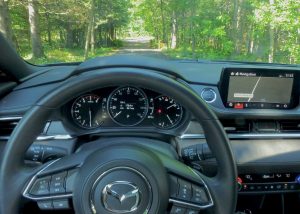
Steering wheel remote switches enhance driving control, and heads-up display helps you spot deer crossing the road.
Ventilated and heated front buckets are power operated, with two preset settings. The 19-inch wheels are fitted with all-season tires, and rain-sensing and de-icing wipers are appreciated.
When all of those features are combined in one very attractive sedan, the case could be made to find a Mazda dealer and negotiate for the 2018 model. We can assume, based on Mazda’s creative styling studios, that the 2019 will be spectacular. We can wait for whatever surprises Mazda might have coming next year, but for now, all of the latest high-tech features are already out, on the 2018 Mazda6.
Including Zoom-zoom tweaked to full “Zoom!”
sportshort
What happened last night in sports up north.
Podcast: Play in new window | Download
New Fiat 124 is Miata kin that loves pasta
Filed under: Weekly test drives, Autos
By John Gilbert
When you climb into a Fiat 124 Spider, right away you forfeit the right to complain about a laundry list of nitpicks that a lesser vehicle would justify arousing.
For example, you can’t complain about a lack of rear-seat room, because there is no rear seat. You can’t complain about its inability to tow
a trailer, or about the fact that a little road or wind noise might creep into the cockpit. You can’t complain that it is a tight squeeze to climb behind the steering wheel, or that it requires a certain level of conditioning to hop out of its driver’s seat.
Those allowances are easily made up for by the sheer joy of driving the 124 Spider, and it has always been thus. Back when the Fiat 124 was all Fiat, with its little Italian heritage and less-than neck-snapping acceleration, in exchange for a completely coordinated sports car, that could take on the best British MGs or Triumphs and deliver satisfaction.
The 2018 Fiat 124 Spider is, of course, the Italian company’s spin on the perpetually satisfying Mazda Miata, now called the MX-5 at least as long as you are within earshot of any Mazda official. Otherwise, we all call it the Miata.
Fiat arranged a deal with Mazda, when it wanted to recreate its old 124’s image, and Mazda provided the platform and bodywork of the Miata for Fiat to play with.
First, Fiat took off the low horizontal grille that has been Mazda’s signature, and fitted it with a lower and wider oval opening that is, come to think of it, a quite-faithful rendition of the old 124, brought up to modern times.
But mainly, Mazda kept its fantastic SkyActiv 20-liter 4-cylinder engine which delivers 155 horsepower and 148 foot-pounds of torque. Nobody ever complains that the Miata is underpowered, because that high-revving, naturally-aspirated 4 keeps revving and giving you easily adequate punch to make a tour around a cloverleaf feel exhilarating.
But Fiat has built its own even smaller engines, and made the most of them with the MultiAir treatment to the valvetrain, and then turbocharging it. In that guise, the Fiat Abarth’s 1.4-liter 4-cylinder is more than 25 percent smaller than the Miata engine, yet puts out 184 horsepower and 184 foot-pounds of torque.
That’s a lot of power from such a small engine, which best defines the wonder of turbocharging to force a greater volume of fuel-air mixture into the engine.
With a 6-speed manual transmission standard, the front-engine, rear-drive 124 Spider feels every bit as perfectly balanced as the Miata, and if it looks slightly less sporty than the Miata, it also has a bit more of a classic appearance, befitting a company that also presented Ferraris to the world for so many years.
The soft-top 124 Spider has a perfectly fitted fabric top, and, like the Miata, doesn’t offer any fancy electric buttons to make it go down or up. But it does offer an amazingly simple manual operation. You could stop at a stoplight when you realize that you should have put the top down before you left. No problem. Reach up and unlatch the single-latching center point on the top, and it pops ajar.
Push the leading edge of the top upward just an inch or so, and relatch the switch so it isn’t dangling, then flip the top up and back, where its perfectly folded and fitted self disappears into itself as you push it back, and as it starts to lower itself into the receptacle behind the tall headrests of the bucket seats, you can reach back — awkwardly, maybe, if you have a sore shoulder — and give it one firm push downward. You are pleasantly surprised at the neat, firm sound as the top clicks down tight.
When you hop out of the car, you might be thankful at how much easier it is to extricate yourself when there is no top, but then look at the refined fit of where the top is folded down on top of itself, leaving a hard fabric-covered panel to face the elements.
Facing the elements is one of the joys of owning a two-seater sports car. You get used to the wind, but the 124 Spider is remarkably adept at channeling the passing wind to keep on passing, without the anticipated turbulence that you might anticipate lifting your baseball cap off your head and flinging it to the roadway behind you.
My older son, Jack, rode with me on a trip from Duluth to near the Twin Cities during the week we had the 124 Spider. I anticipated him grumbling and complaining about the wind, but he — undoubtedly anticipating me grumbling and complaining if he grumbled and complained — never uttered a word of dissent.
I put the top down, we strapped ourselves into the buckets, and we were off. It was about a 2-hour drive, and we were comfortable the whole way, registering 32.5 miles per gallon as we sailed along at the 70 mph limit, or whatever any other motorists might be establishing as the norm.
I have my own set of rules for a two-seat roadster. One is that if it is foul-weather and you need to put the top up, go ahead. But if you put it down, then lower the side windows. True, if it gets nasty you might be tempted to power them up, but to me, nothing looks clunkier than a two-seater with the top down and the side windows up. Just a personal thing.
With the top down, getting in a neat trick, too. You don’t need to be a gymnast to put your feet in on the floor while you swing your rear end in and place it against the backrest, then lower yourself down and in perfect place in the seat. You can pretend you are climbing into a Formula 1 car if you choose, but it’s just a neat touch.
Touring suspension and electronic stability control undoubtedly had a hand in the handling, although it simply is incomprehensible that the 124 Spider wouldn’t handle with superb, flat stability no matter how aggressively you threw it into a turn. The turn-in is predictably precise, seemingly designed for how hard you might want to zip around curves.
It has air-conditioning, although that seems superfluous in most instances. It doesn’t have power seats, either, which is no big thing, because there is precious little room, or need, for much adjustment. It does have power outside mirrors, which I found interesting.
It has an adequate trunk, as long as you don’t plan on hauling three weeks of luggage with you on your trip to the shopping center.
The 124 Spider also has nice options such as satellite radio and a navigation system with a small but adequate screen, and it has a back-up camera and voice-commanded Bluetooth connectivity. Three-season performance tires are mounted on the 16-inch alloy wheels, which indicates you might want to invest in special winter tires, or, better yet, park the 124 Spider unless there are a few of those sunny, dry winter days in your climate.
Projector headlights and LED taillights set off the car, fore and aft.
The test car showed up with a base sticker price of $24,995, which also was a pleasant surprise, and with the few options it still listed for $27,385.
That is a small price to pay for a vehicle you will pamper and enjoy for as many years as you care to own it. It is not a Porsche, certainly, or a Corvette, but you might enjoy engaging those super-powered sports cars in a neighborhood autocross and surprise them.
Sure, you can make the 124 Spider perform, but almost immediately you will find that your pleasure will mainly come from pleasing yourself at the adroit handling and quick-revving, barking engine performance. And that’s more than enough to make the drive to work, or home from work, a time of pure pleasure.
Nissan offers reason to turn over a new Leaf
Filed under: Weekly test drives, Autos
By John Gilbert
If you’ve never heard about Guy Clark’s fabulous song-writing, find a way to get your hands on his “Best of the Dualtone Years” album and anticipate about six months of fantastic entertainment. In his classic “Texas, 1947,” he wrote about the people coming down to the depot to see the first diesel train speed past, and he says the folks were “…wondering what it’s coming to, and how it got this far.”
If it was written more recently, Clark might have been inspired by driving the new Nissan Leaf, an all-electric vehicle that can truly push any observer to such puzzlement.
There have been many stories about the development of electric cars, such as the privately owned Tesla vehicles, and virtually every manufacturer either has experimental models on the streets, or is nearing production status.
Nissan, meanwhile, simply acts where rivals promote, and it brought out the Leaf almost a decade ago and started selling them, mostly on the West Coast, but also in the East and in Florida. Now they sell them all over the U.S. Looking a lot like a subcompact Versa, sort of boxy and unexciting, the Leaf was swift and performed well, and it stands as the No. 1 electric car sold worldwide, a status it has attained quietly — literally and figuratively.
For 2018, Nissan has redesigned the Leaf, making it look very Nissan like from the signature nose, and positively futuristic from the rear and side. Suddenly the Leaf has enough appeal to lure mainstream customers, not just those who are insisting on not paying the wildly fluctuating $3-plus per gallon of gasoline. If they go to a Nissan dealer and test-drive one, they will be more impressed.
You can buy a Leaf SL for a base price of $36,200, or a loaded, as-tested SL for $38,510. That, however, is before you figure out the tax-break deductions a zero-pollution vehicle can get. Best estimates are that a loaded Leaf might be obtainable for around $27,000. That’s about half what a Tesla Model 3 goes for, and close to half of a new Chevrolet Bolt EV.
I was eager when I learned I would get a 2018 Leaf for a week-long test drive. I was less impressed when the delivery service showed up with the Leaf riding comfortably on the back end of a flat-bed hauler. I had been hoping it would be driven here, because even though it started out in Chicago and would have stopped for a few recharging sessions, it would have meant the Leaf’s range was sufficient to consider it an everyday driving candidate.
The plan is that the 2019 Leaf will g a larger and more powerful battery-pack, which could boost between-charges driving range to up near 300 miles.
As it is, the 2018 test model showed a range of 150 miles between charging sessions, which is certainly more than adequate for driving to and from work and tossing in a venture out for dinner and maybe a movie or the shopping center, knowing you can plug it in overnight and be ready to go in the morning.
My wife, Joan, and I decided to make it an adventure, planning to drive from Duluth, Minn., to the tiny Wisconsin vacation town of Lake Nebagamon, nearly 50 miles from our home. Joan had spent part of every childhood summer at her grandma’s home there, and she vividly recalls the fun of spending whole days at the public beach, with highlights of her first-ever experiences with a new Minnesota delicacy — Dairy Queen — which was, and still is, about 100 yards up the boat-launching slope from the water.
I’m not sure how many Nissan Leafs (Leaves?) have ever appeared in Lake Nebagamon, but a measure of how far it has gone was that numerous passers-by glanced at it, or even looked hard at it, but didn’t seem to think it was anything unusual.
For those people, it’s always most fun to hop in the Leaf, hit the starter button, and hear the engine roar to life. Just kidding! There is no noise — zero. You simply shift into gear and take off swiftly while those passers-by gaze after you with some degree of marvel. Even if they never heard of the late Guy Clark, and his fantastic Texas folk-country song-writing.
Nissan is a Japanese giant that tends to forge ahead, rather than spend time promoting its newest stuff, and the Leaf is a perfect example. Back in 2010, Nissan invited auto media to Tennessee to first drives of the new Leaf, and I’ll never forget the instant acceleration and completely silent operation, which was the stuff of Star Wars. Then I swapped seats with my conservative-seeming co-driver and observed him hammer the “gas” pedal. We went faster and faster, very quickly, still not making a discernible noise. I glanced over at the instruments and noticed we were sailing along at 103 miles per hour. We had been told the Leaf might go 90 or so, but unless the speedometer was wacko, our test vehicle easily surpassed that. It reached showrooms as a 2011 model.
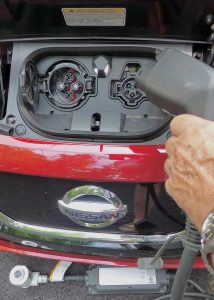
Convenient plug location for normal or quick charging replenishes gasoline-free range of over 150 miles.
The only question then, as now, is the range you can go before you run out of electric power and need to plug in. Over the years, battery-makers have gotten better and better, with each plateau of sophistication meaning quicker recharge, greater capacity, and longer range. Companies like Panasonic, Sanyo, Samsung and various others, up to and including LG from South Korea, have reached amazing levels.
That wasn’t good enough for Nissan, which went ahead and built its own facilities for building the necessary batteries to make hybrids, and pure-electric cars, function. The Leaf is built in Smyrna, Tennessee, and the battery pack is built in Smyrna, Tennessee.
The current 2018 Leaf SL test vehicle has a 40 kilowatt-hour Lithium-ion battery that operates a 110 kilowatt-hour synchronous motor. It also has 6.6 kilowatt onboard charger, and a quick-charge port. My mind boggles at the idea of trying to equate kilowatts to horsepower, whether battery or motor. (Did you know that you can call an electric motor a “motor,” while a gasoline engine is an “engine?”)
So to unboggle my mind, my best measurement of an electric car is to get in, hit the starter button, engage the “D” tab on the shifter and hit the go pedal. Then try to calculate how swiftly the fence posts or trees whiz past.
We’re used to gasoline engines, which roar louder and louder as the RPMs build, leading to the horsepower peak at somewhere up around 5,000 revs. Electric motors, on the other hand, have maximum torque at zero RPMs. So when you take off, you really take off.
Best estimates show the Leaf going 0-60 in about 7.5 seconds. I didn’t check. All I knew was it was fast enough, and because there is only silence, you need to pay attention to your speedometer.
Other settings on the instruments can be switched to give you remaining range and percentage of remaining electricity stored in the Leaf battery pack.
We plugged the adaptor cable into the nose receptacle, and the other end into a three-pronged 220 plug in our garage. That’s the middle of three methods of recharging. Level 1 is into normal household 110-120, which takes about 10 hours for a full charge, and Level 2 is to plug into a 220 outlet, which can recharge full in 4 hours. Level 3 is a high-end charging station, of which there might be a lot in California, and get about 85 percent recharge in about 20 minutes.
In Duluth, Minnesota, with its legendary winter cold, there are a grouping of EV charge stations about a block south of Superior Street, and at the north tip of the main Canal Park motel, restaurant and entertainment area. You plug in, swipe a credit card, and return from a nearby movie or dinner to a fully charged car.
We plugged in at home, overnight, and found the instruments told us we had 93 percent maximum charge, worth a range of 158 miles. The max is supposed to be 150 miles, but like hybrids, electric vehicles learn your driving style and adapt immediately. If you drive economically, your range will increase. If you drag race your neighbors on the way to work, it will go down.
Same with severe cold. I know from past experience the best batteries in cameras, tape recorders, audio players and electric-aided cars plunge quickly when exposed to extreme cold. I’m not sure about the newest Leaf, but extending the range is the primary concern. We know we can park it in a garage overnight, dash to work, and no matter how cold still have enough juice to get home.
As for our trip to Lake Nebagamon, we zipped over the big bridge into Wisconsin, then followed our GPS down the little roadways to the town. We drove around for a while, making sure to locate the house once owned by Joan’s grandmother, toured town briefly, but totally, then parked down by the beach.
We also walked around a bit to check out assorted locations, then had a ceremonial Dilly Bar at the Dairy Queen before heading back toward Duluth.
During the rest of the week, we drove up hills and down, and checked out the fantastic “e-pedal” switch, which assures you of instant deceleration whenever you lift off the accelerator. It reverses the motor, capturing regenerative electric power to ostensibly increase your range. But in Duluth, where you face a lot of steep hills, you went up swiftly, and could go down efficiently by lifting your toe and letting the car slow itself.
It works so well that if you are approaching a car ahead stopped at a light, you can let off and it will slow you down completely to a stop. Outstanding.
Interior appointments aren’t fancy, but they’re effective. Leather seating, complete and simple instrumentation and a potent audio system are all standard features, as is the normal high-tech driving aids such as vehicle dynamic control, blind-sport warning, rear cross-traffic alert, and more common stuff such as traction control, antilock brakes and electronic brake assist and distribution.
I was startled by one feature. The automatic braking and accident-avoidance feature is, in a word, sensitive. Joan and I went to a movie with an adjacent parking lot, and because of construction you can only leave by driving through the bottom level of a ramp and proceed through an automatic rising horizontal arm. I advanced slowly, and when I was first in line, I drove ahead slowly, timing the arm as it rose.
Suddenly — very suddenly — the car emitted a nasty growl and stopped on a dime. I was sure something had broken or malfunctioned. Then I realized it was the avoidance system, which caught the radar bounce of the rising arm and inspired the Leaf to stop instantly.
We’re all going to be driving hybrids or electric vehicles of some sort someday, or sooner. When you realize the price sticker shows the fuel-economy equivalent of 112 mpg city and 100 highway, you also realize that if you drove the Leaf for 10 years, to work and back every day, and on trips whenever you felt comfortable with the range, you would spend a grand total of $0 for gasoline.
Think about it, while you’re listening to Guy Clark wondering where it’s coming to and how we got this far. We’re going to be coming farther, and soon.


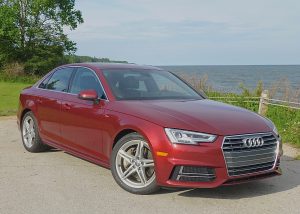
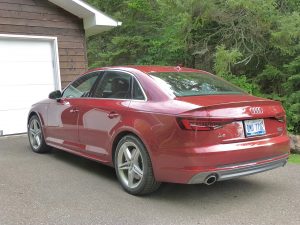

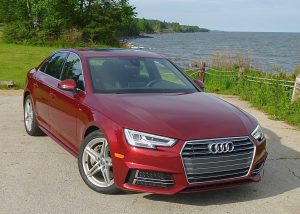
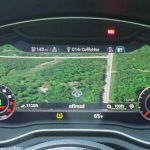
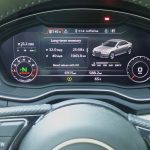
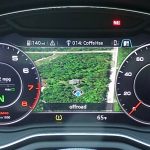
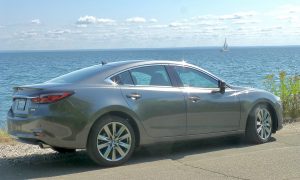
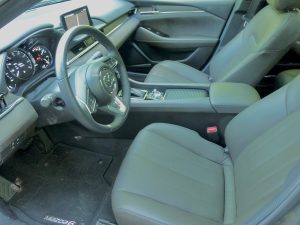
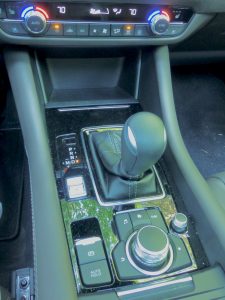
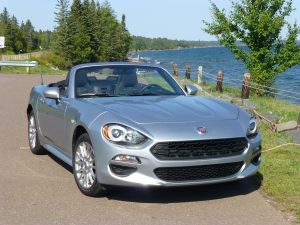
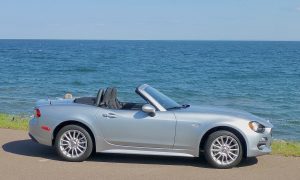
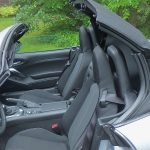
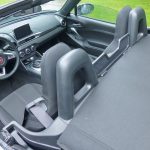
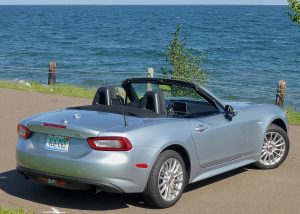

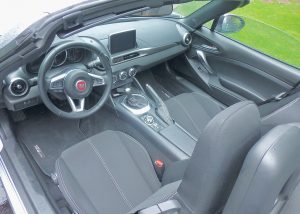
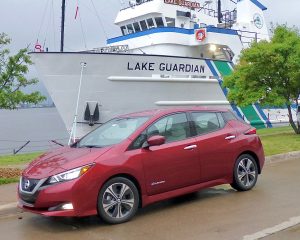
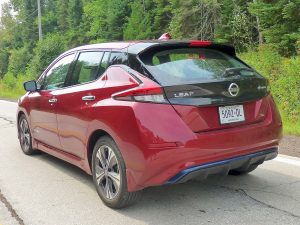
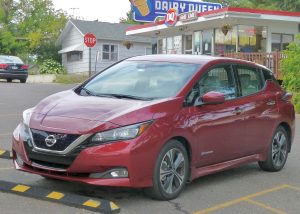
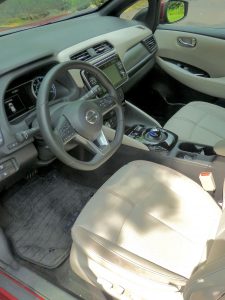
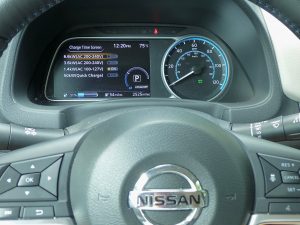
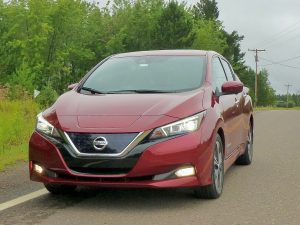
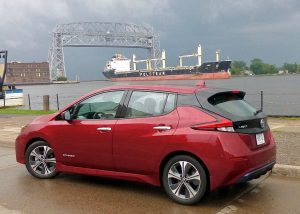
 John Gilbert is a lifetime Minnesotan and career journalist, specializing in cars and sports during and since spending 30 years at the Minneapolis Tribune, now the Star Tribune. More recently, he has continued translating the high-tech world of autos and sharing his passionate insights as a freelance writer/photographer/broadcaster. A member of the prestigious North American Car and Truck of the Year jury since 1993. John can be heard Monday-Friday from 9-11am on 610 KDAL(www.kdal610.com) on the "John Gilbert Show," and writes a column in the Duluth Reader.
John Gilbert is a lifetime Minnesotan and career journalist, specializing in cars and sports during and since spending 30 years at the Minneapolis Tribune, now the Star Tribune. More recently, he has continued translating the high-tech world of autos and sharing his passionate insights as a freelance writer/photographer/broadcaster. A member of the prestigious North American Car and Truck of the Year jury since 1993. John can be heard Monday-Friday from 9-11am on 610 KDAL(www.kdal610.com) on the "John Gilbert Show," and writes a column in the Duluth Reader.